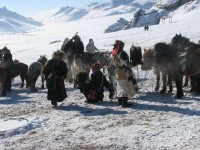By Hazel Southam, UK Telegraph
Mongolia is one of the toughest places on earth to live and can boast the coldest capital - Ulaanbaatar - on the planet. Temperatures drop to at least -30C in winter. The country is frozen from November to March. But four climactic disasters, known as ‘dzuds’, since 1999 have made life almost impossible for even the toughest of Mongolia’s nomadic people who roam over a country three times the size of France. Three particularly harsh winters since 2000 have killed a third of the nation’s livestock.
In 2001, the temperature dropped to a record-breaking -57C. Some 15,000 herders lost all of their animals through starvation and cold, and with them, their money and food. More than a quarter of the 2.6m population has left the vast rural areas, where herdsmen have lived since before Ghengis Khan’s empire was established in the 13th century, and have fled in desperation to the cities.
Among them is Byambaa Nurdev (22) a former herder in the Gobi Desert. She and her husband Tumenbayar (31) had some 600-700 sheep and goats, making them relatively wealthy. But between 2002-2005 they lost every single animal. Mongolia’s image as a land of nomadic herdsmen may be about to change for good as harsh weather conditions threaten their traditional way of life and bring more herdsmen off the land into an uncertain urban future. Read more here.

Larger image here
We may just face a planetary emergency after all—Global COOLING!
By Hazel Southam, UK Telegraph
Mongolia is one of the toughest places on earth to live and can boast the coldest capital - Ulaanbaatar - on the planet. Temperatures drop to at least -30C in winter. The country is frozen from November to March. But four climactic disasters, known as ‘dzuds’, since 1999 have made life almost impossible for even the toughest of Mongolia’s nomadic people who roam over a country three times the size of France. Three particularly harsh winters since 2000 have killed a third of the nation’s livestock.
In 2001, the temperature dropped to a record-breaking -57C. Some 15,000 herders lost all of their animals through starvation and cold, and with them, their money and food. More than a quarter of the 2.6m population has left the vast rural areas, where herdsmen have lived since before Ghengis Khan’s empire was established in the 13th century, and have fled in desperation to the cities.
Among them is Byambaa Nurdev (22) a former herder in the Gobi Desert. She and her husband Tumenbayar (31) had some 600-700 sheep and goats, making them relatively wealthy. But between 2002-2005 they lost every single animal. Mongolia’s image as a land of nomadic herdsmen may be about to change for good as harsh weather conditions threaten their traditional way of life and bring more herdsmen off the land into an uncertain urban future. Read more here.

Larger image here
We may just face a planetary emergency after all—Global COOLING!




